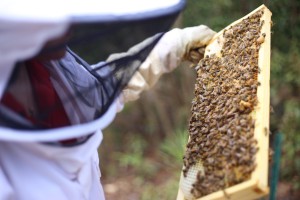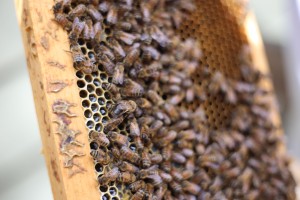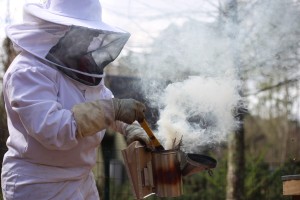

Decatur’s Oakhurst neighborhood features a mural painted last month depicting smiling people planting flowers, surrounded by rabbits, birds and mostly importantly, bees.
Oakhurst’s mural is one of many places Atlanta residents can commune with bees, and not just the ones in paintings. A quick Google search will reveal a slew of recent articles about urban beekeeping.
Holly Bayendor McConnell is a certified beekeeper and president of the Metro Atlanta Beekeepers Association (MABA). She thinks articles like these can positively influence bee health.
“The media attention it’s received, the silver lining is, hopefully everyone is more aware and trying,” McConnell said.
Honey bee populations have been under serious strain in the past 30 years and their plight has come into sharp focus. The majority of beekeepers keep only a few hives in urban and suburban areas, making them the recipients of much of this attention, according to the Georgia Department of Agriculture.
Beekeeping in Atlanta thrives despite continuing fears about bee health. Hives can be found right in the city, such as those on top of the Four Seasons Atlanta, or in surrounding neighborhoods, and the beekeeping craze continues to spread.
—–
BEES IN TROUBLE
Honey bees have been facing serious health problems since the 1980s, when a host of new diseases and pests exacerbated concerns about habitat diversity and the negative effects of pesticides. However, another perplexing problem plagues today’s bee population.
It is known as Colony Collapse Disorder (CCD) and its effects are disastrous: bees suddenly disappear, usually leaving behind a healthy queen and immature brood.
A Pennsylvania beekeeper reported the first documented case in 2006, and researchers have been baffled ever since. The cause of CCD has yet to be proven, according to the United States Department of Agriculture.
According to Beeinformed.org’s colony loss research, nearly 23.9 percent of Georgia hives died during the winter of 2014 and 2015. The number is closer to 30 percent nationwide. This statistic does not distinguish between hives affected by CCD and hives that died naturally during the winter, a common occurrence that beekeepers face every year. However, it is a sharp increase from 2006 and earlier, when the average winter death rate was a mere 14 percent nationwide, according to The Washington Post.
—–
THE REAL DEAL WITH PESTICIDES
Jennifer Berry is the Apiculture Research Coordinator for the University of Georgia’s Honey Bee Program.
“Everyone’s saying that pesticides are killing the bees when in actuality, all the research points towards varroa mites,” Berry said. “That’s the number one reason bees die.”
Varroa mites are parasites that only attack honey bees and cause a disease that stunts growth and fertility. They were first introduced to the U.S. in the late 1980’s, and are the primary focus of Berry’s research lab.
Berry says the number two killer of bees is starvation. Beekeepers can accidentally starve their hives by collecting too much honey, leaving the bees with nothing to eat during the winter.
In the wild, habitat loss due to agriculture and development creates a dearth of foraging sites, according to greatpollinatorproject.org. Many species of bees favor specific habitats and suffer even when new flora is introduced, such as when weeds are replaced with grass in new neighborhoods.
Berry stresses that while pesticides are bad for bees, starvation and varroa should not be overlooked.
—–
DON’T WORRY, IT’S NOT THE “BEE-POCALYPSE”
Despite these losses, the number of honeybees colonies in the US has generally been rising since 2006, according to data released by the USDA last year.
CCD has inspired a new push for backyard and urban beekeeping, as more and more people are getting informed and pitching in. McConnell got her start this way.
“In 2010, I saw a documentary on PBS called ‘The Global Decline of the Honey Bee’,” McConnell said. “I thought, ‘I have a backyard, how hard could it be?’”
She joined MABA and chaired the Junior Beekeepers, a program that introduces children to beekeeping, before becoming president last January.
—–

HOW TO GET INVOLVED
Beekeeping is no longer reserved for devoted farmers with thousands of hives. It has moved into cities and backyards and is becoming a hobby for people with day jobs who keep a few hives wherever there is space.
“MABA has about 200 members, and almost all of them have bees scattered across the metro and greater Atlanta area,” McConnell said.
Atlanta’s warmth and greenery make it ideal for urban and suburban beekeeping, and MABA focuses on keeping the community strong and fruitful.
Mentors offer house calls to beekeepers with questions or concerns, and are available to advise people who are considering getting a hive but may not know where to start. They also offer a short course every January, a one day crash course in everything a beginner needs to know to successfully install and care for a hive.
MABA’s monthly meetings are open to the public and feature different speakers, including researchers and master beekeepers such as Jennifer Berry, who speaks there twice a year.
Most counties in Georgia have beekeeping organizations where newbies can find support. Even city dwellers need not fear their urban setting, as many people keep hives on the roofs of their apartment buildings. Community gardens also offer opportunities for hands on experience.
Caring for a hive isn’t for everyone. It’s a big commitment. New beekeepers need to remember that the work continues even after the hive is installed.
“Bees are like pets, some people don’t realize that,” Berry said.
There are plenty of ways for concerned citizens to encourage bee health without taking on the responsibility of a hive. Berry recommends homeowners eliminate or heavily reduce pesticide use in their yards, and limiting herbicides on lawns surrounded by flowers.
Even the small things count. As an alternative to extermination, calling a local beekeeping organization to have a pesky swarm removed for free. Choosing plants that provide shelter and food makes a difference, as well.
Many annual flowers, the kind sold at stores like Home Depot that keep beautiful petals for months at a time, are bred not to produce nectar. Shrubs, zinnias, bee balm, sunflowers and other nectar rich plants can make any porch or yard a bee-friendly habitat.
—–

THE TAKE-AWAY
Beekeeping today is more than just a fun hobby or convenient honey tap. The situation isn’t as bleak as it was a few years ago, but, for McConnell, there’s still a long road ahead.
“Don’t be afraid of bees, be afraid for them,” McConnell said. “They do a lot of good for us, and we like having them around.”
—–
HOW YOU CAN HELP:
- Plant bee-friendly flowers: Some plants are better for bees than others. They love sage, lavender, sunflowers, honeysuckle and rosemary.
- Leave Your Weeds: “Let your weeds grow, and try not to use weed killers,” McConnell said. Weeds like dandelions are classified as wildflowers and make excellent food sources for bees.
- Limit Pesticide Use: While CCD cannot be attributed solely to pesticides, the bees will nonetheless thank you for some chemical free forage.
- Buy Local: Support local farmers, especially polyculture and organic farms. Buy local honey too.
- Share With Your Community: Encourage your neighbors to create a safe space for bees in their yards, too.
—–
DID YOU KNOW?
- Bees communicate by dancing.
- Bees secrete sheets of wax like sweat.
- Approximately 98 percent of the hive is female; males, called drones, die after breeding with the queen.
- Honey is the only insect made substance that human eat.
- That distinctive buzz is created by the bee’s wings, which beat at 200 beats per second.
